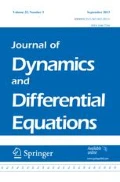Abstract
A structured population model of a single population having two distinct life stages is considered. The model equations, consisting of a hyperbolic partial differential equation coupled to an ordinary differential equation, can be reduced to a single, scalar functional differential equation. This allows us to use the well-developed dynamical systems theory for functional differential equations in order to study the dynamical system generated by the more complicated coupled system. A precise relation is established between the dynamical systems generated by each system of equations and a correspondence between their respective global attractors is made. The two systems are topologically equivalent on their respective attractors. These relationships are used to determine sharp sufficient conditions for the uniform persistence of the population.
Similar content being viewed by others
References
Blythe, S. P., Nisbet, R. M., and Gurney, W. S. C. (1984). The dynamics of population models with distribution maturation periods.Theor. Pop. Biol. 25, 289–311.
Calsina, à. (1991). A nonlinear model for size-dependent population dynamics.International Conference on Differential Equations, Barcelona, eds. C. Perelló, C. Simó, J. Solà-Morales, World Scientific, 1993, Singapore.
Hale, J. K. (1977).Theory of Functional Differential Equations, Springer-Verlag, New York, Heidelberg, Berlin.
Hale, J. K. (1980).Ordinary Differential Equations, R. E. Krieger, Malabar, FL.
Hale, J. K. (1988). Asymptotic behavior of dissipative systems.AMS Math. Surv. Monogr., No. 25.
Kirk, J., Orr, J. S., and Forrest, J. (1970). The role of chalone in the control of the bone marrow stem cell population.Math. Biosci. 6, 129–143.
Metz, J. A. J., and Diekmann, O. (1986). The Dynamics of Physiologically Structured Populations,Lecture Notes in Biomathematics 68, Springer-Verlag, New York.
Nisbet, R. M., and Gurney, W. S. C. (1983). The systematic formulation of population models for insects with dynamically varying instar duration.Theor. Popul. Biol. 23, 114–135.
Saperstone, S. H. (1981). Semidynamical Systems in Infinite Dimensional Spaces,Appl. Math. Sci. 37, Springer-Verlag, New York.
Smith, H. L. (1987). Monotone semiflows generated by functional differential equations.J. Diff. Eq. 66, 420–442.
Smith, H. L. (to appear 1994). Existence and uniqueness of global solutions for a size-structured model of an insect population with variable instar duration, to appear.Rocky Mt. Math. J. (in press).
Smith, H. L. (1993b). Reduction of structured population models to threshold-type delay equations and functional differential equations. A case study.Math. Biosc. 113, 1–24.
Sulsky, D., Vance, R. R., and Newman, W. (1989). Time delays in age-structured populations.J. Theor. Biol. 141, 403–422.
Thieme, H. R. (1993). Persistence under relaxed point dissipativity.SIAM J. Math. Anal. 24, 407–435.
Webb, G. F. (1985).Theory of Nonlinear Age-Dependent Population Dynamics, Marcel Dekker, New York.
Author information
Authors and Affiliations
Rights and permissions
About this article
Cite this article
Smith, H.L. A structured population model and a related functional differential equation: Global attractors and uniform persistence. J Dyn Diff Equat 6, 71–99 (1994). https://doi.org/10.1007/BF02219189
Received:
Issue Date:
DOI: https://doi.org/10.1007/BF02219189




